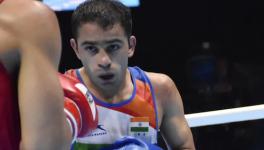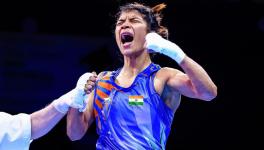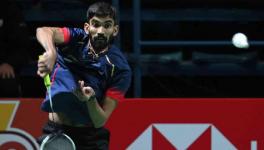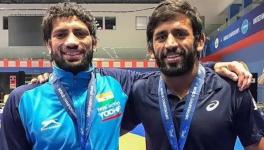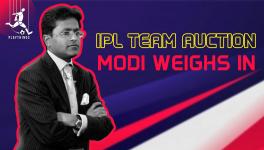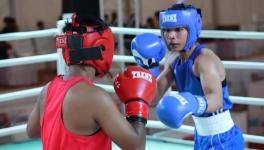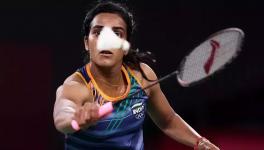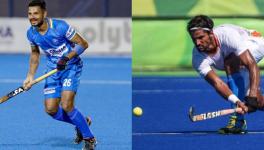Mary Kom: Boxing World Moves On, India Remains Unchanged
MC Mary Kom start as one of the favourites for a medal in the 49kg category at the AIBA Women’s Boxing World Championships to be held in New Delhi from November 15-24 (Pic: BFI).
By about 7pm the boxing training hall at the Indira Gandhi (IG) Indoor Stadium was almost deserted. The silence was broken up, every now and then, by a straggler still working the heavy bag in some corner or the whip of the skipping rope that is soundtrack of a boxing gym. The scene had been dramatically different hours previously. With the AIBA Women’s World Boxing Championships — to be staged at New Delhi’s IG Stadium from November 15-24 — round the corner, there was an air of urgency among the dozens of boxers who filled the hall. The likes of Sarita Devi and Simranjit Kaur, and the younglings, including Manisha Moun, Sonia and Lovlina Borgohain, in the Indian boxing contingent, also went through a quick session — padwork and punching drills — lasting about an hour.
Among the few left, after training, was the ambassador of women’s boxing’s global showpiece — MC Mary Kom. The star of the home team was going through a post-workout stretching routine in one of the three practice rings and cracked a couple of jokes as we approached her. The 35-year-old champion seemed relaxed, her jovial mood indicative of the zone she is in at the moment: “Happy” with the long and successful career, “glad” with the “shape and form” she is in at the moment, and “excited” to be boxing for the world crown at home. It will be her sixth if she manages to win here.
But a long and tough campaign stands between her and gold in a week’s time, and Mary knows it. That’s how women’s boxing has taken off, she explained, settling into a light-hearted conversation laced with some sharp, sarcastic and introspection-demanding jabs at Indian boxing.
Also Read | Opening Highs: Indian Women’s Cricket Team on a Roll at ICC World T20 in Caribbean
Mary had just finished a “novel” training session in which she sparred with boxers from other teams. “World Championship could end up being a friendly,” she jokes, before adding that the system, new to boxing, is fun and a great learning experience.
“It’s a new experience, sparring with boxers from other countries before the competition,” she adds. “There is a lot that we get to learn, and a lot they learn too. It’s good for the sport, the learning.”
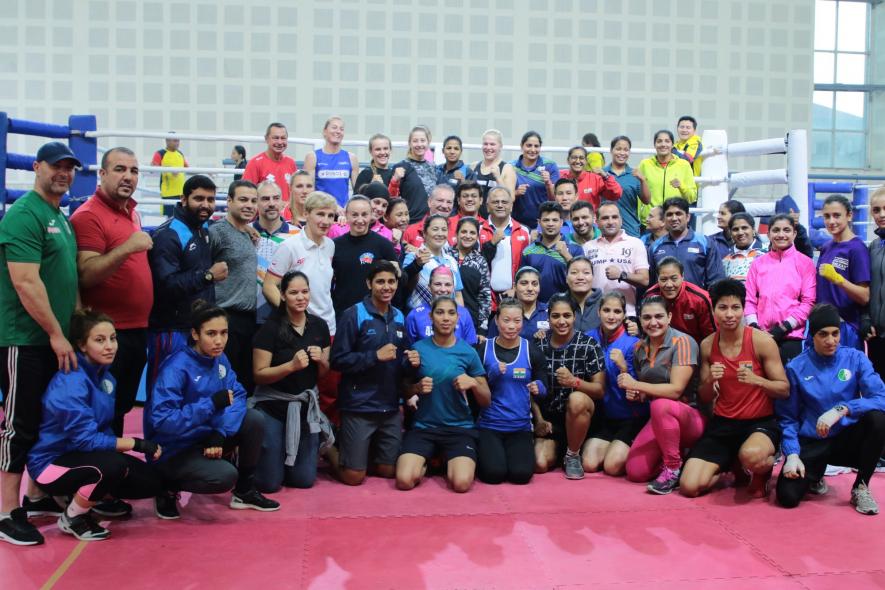
Indian and international boxers pose for a group photograph during training ahead of the AIBA Women's World Boxing Championships in New Delhi.
Mary believes it is the willingness to learn, to adapt, that has made her last so long in what has now become an ultra competitive arena. The transformation of women’s boxing began after being included in the Olympic programme in 2012. Mary is impressed with the base that has been established — growing numbers in boxing gyms; champions from different parts of the world.
“The boxers are far better than, say, the time I began competing at the world level, back in 2001,” she explains. “They are faster, smart and clever, and technically more solid. Of course, after the inclusion in the Asian Games, the Commonwealth Games (CWG) and the Olympics, things have taken off. Now boxers have more exposure and gain experience from fighting against tough opponents frequently. That has changed many things including the way women train. They employ new methods, train as hard or even harder than the men. The demands are such. It is going to be a tough tournament, this one.”
The evolution of women’s amateur boxing augurs well for the mission of the International Boxing Association (AIBA). The effort for boxing, like all sport in the Olympic programme, is to remain relevant in appeal, and thereby, in the revenue making scheme of things. A tough ask when we consider that amateur women’s boxing has to contend with the men’s segment, and also with the rising appeal of mixed martial arts (MMA) and women’s pro boxing.
Also Read | Virat Kohli Should Stick To Batting and Spare India His Cricket Nationalism
However, the rarefied dream of winning an Olympic medal has lured even professional boxers into the AIBA fold. Many, like Colombia’s Dayana Cordero Hernandez, a former interim WBA world female bantamweight belt holder, are in New Delhi pursuing that Olympic dream. Their presence has added much more punch, pun intended, into women’s boxing.
So where does India stand in the global context of the sport? The international women’s boxing community looks up to Mary Kom as an inspiration, and her journey is highlighted in all its efforts at increasing the reach of the sport. Her country, however, seems stuck in a time warp that goes back to when Mary began her quest for world domination.
That would be 12 odd years back, in the mid 2000s. When New Delhi hosted the women’s World Championships in 2006, India won eight medals, including four gold. Two of those gold medallists are still in the team now — Sarita and Mary. In the years since, the sport has exploded. The upcoming championships will feature close to 300 boxers from 70 nations. While the sport has grown globally, Mary sees a clear indicator of how India has kept pace. “Now what can I say about where we stand in world boxing,” she says. “The results we all can see.”
Things have not been rosy for Indian boxing this year. The women returned with no medals from the three categories (51, 57 and 60 kg) in which competitions were held at the Asian Games in Jakarta-Palembang, Indonesia. Earlier in the year, at the Commonwealth Games on the Gold Coast, Australia, Mary’s gold medal was the saving grace for an otherwise bleak outing. Indian boxing’s high performance director, Santiago Nieva, realises the shortcomings.
Also Read | Manpreet Singh to Lead Young Indian Men’s Hockey Team at FIH World Cup in Odisha
“We have good girls who are close to the international level,” said the coach from Sweden. “Of course, we have Mary Kom. We have other boxers who have won medals at the World Championships. But, at the same time, we didn’t win any medals at the Asian Games and at the CWG we won only one. The competition out there is super tough and one has to perform at the best level to reach the medals round. Now, this tournament will show us where we stand [as far as the global standards are concerned].”
There would be home advantage for the women, and as Nieva puts it, the “positive pressure” to perform and win medals would push the Indians to a higher level. Then again, the coach and the management are also in two minds about how relevant these World Championships are as far as the Olympic cycle is concerned.
Two years away from the next Games in Tokyo, athletes would be hoping and aspiring to peak for the Olympic qualifiers and the big show. The tournaments this year would only be stepping stones to that larger goal. However, that is is not the case for India, where Asian Games and the CWG, events which provide opportunity for many of our athletes to perform and win on the international stage, are important. So much so that the results in these events are scrutinized more than, say systematic progression needed in order to peak at the Olympics.
And so, one would love to give the women the benefit of the doubt for their poor performances recently, keeping the Olympic cycle in mind. Mary, while agreeing to the peaking process, also feels the slide in performance is part of more serious shortcomings.
Also Read | No Country for Adventure: Challenges Extreme Sports Athletes Face in India
Boxing is a fast sport not just in the ring. The journey of the athlete has to be quick too. Mary points out that Indians, in general, take time to mature as boxers, losing valuable years in the process.
“Our boxers pick up very slow,” she elaborates. “That is the main difference between us and the best boxers out there. Our boxers may pick up later on but then [in most cases] it proves to be too late for them. If we pick up very fast that’s an advantage. This [process of moulding a boxing career] is something we should learn from them.”
The gradual learning curve is unjustified when you consider the kind of resources the current crop gets from the Boxing Federation of India (BFI) through the Sports Authority of India (SAI).
“I have nothing to comment about where our boxers stand [compared to the world standards],” she says. “You have seen the achievement and would have realised that no one is coming up. For this World Championships, everyone is working very hard — the boxers, the federation, SAI and the ministry. You can look around and see the number of support staff available for us. In the past, we had nothing, we had no doctors or physio. We used to have just five coaches for the team and lemon juice, that’s all.”
Also Read | Bajrang Punia’s New-Found ‘Strengths’ Cost Him Gold at Wrestling World Championships
That life-giving-Indian-boxers-lemons days are truly over indeed. But, that has coincided with a dearth of genuine and consistent contenders on the global stage. We are not just talking about medals here but quality of boxers. The fact that Mary Kom or Sarita Devi, despite their age, still don’t have serious challengers in the national fold to take over their position in the team is an indicator in itself.
“I can’t predict the future of the young boxers and whether they would go on to do it [win medals at the Worlds and Olympics],” she adds, pointing out that the youngsters seem to live in silos and don’t reach out to seasoned boxers for tips or guidance.
“The junior boxers never approach me for tips, for instance,” says the London Olympics bronze medallist. “If they come I am more than happy to help or guide or share from my experience.”
Then again, boxing is a sport which embeds a certain amount of individualism in the fighters. They love to trace their own paths, while at times, it could be egos that come in the way. While a fighter’s ego is an asset in the ring, it could hinder learning too. It’s time for Indian boxing’s think-tank’s to figure out how to overcome these challenges to ensure boxing doesn’t get stuck and stale, and too far behind the world.
Get the latest reports & analysis with people's perspective on Protests, movements & deep analytical videos, discussions of the current affairs in your Telegram app. Subscribe to NewsClick's Telegram channel & get Real-Time updates on stories, as they get published on our website.









